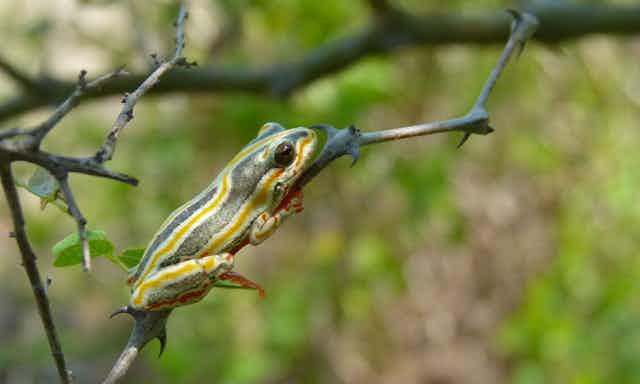This article is the fourth in a series. The Conversation Africa is running on invasive species.
A bunch of bananas seems like an unlikely mode of transport for frogs to invade the world. But it’s not far-fetched. In South Africa bananas are moved extensively around the country and are a significant pathway for the movement of frogs from one area to another.
But bananas aren’t the only fruit or vegetable that enables frogs to move around.
Take South Africa’s painted reed frog (Hyperolius marmoratus) which originally came from the southern Cape. Aside from hopping onto a piece of fruit, it used caravans and nursery plants to expand the areas it lives in. The species is now found all across the Western Cape Province.
Not all invasive frogs come from the same country. Some make it from one continent to another, such as the cane toad which is now highly invasive in Australia.
Identifying how species are moved from one place to another involves studying the pathways provided by human trade and travel, and determining how they can be controlled to prevent new introductions that might lead to invasions.
We set out to research how southern Africa’s frogs move around the region. Invasive frogs can have a major impact on the environment. They can bring diseases or parasites and can poison other animals that try to eat them.
By studying invasions in southern Africa we have been able to understand how frogs might invade the region in the future. This opens the door to designing policies that can ensure those that cause harm can be managed.
Invasion pathways
The movement of frogs on plants, vegetables, and fruit is known as jump dispersal. We found that there are many different kinds of invasion pathways. These include:
leading-edge dispersal: animals colonise neighbouring water bodies close to the edge of their range;
corridor dispersal: species move along a convenient river or valley;
extreme long-distance dispersal: when frogs creep into a shipping container for example; and
cultivation dispersal: where animals that were purposefully bred for export to a new region, then escape and multiply.
Bad invasions
A number of frog species that were introduced to new regions for specific purposes and then escaped have become notorious because of the damage they’ve caused.
The Cane Toad was introduced to more than 40 countries in the 1930s as a biological control agent against a boring beetle in sugar cane. The toads were ineffective at beetle control, but they thrived in most areas of their invasive range, especially Australia. Today, predators that eat them suffer the effects of toad toxins.
North American Bullfrogs, initially grown for culinary purposes were exported to other countries, particularly Europe where frog legs are considered a delicacy. They are large and predatory and consume other frogs in great numbers making it difficult for other species to share their habitats.

The African clawed frog originated in South Africa but was transported across the western world, in the first instance, for use as pregnancy tests during the 1930s. Pregnancy was confirmed by an injection of urine from the patient leading to spawning in lab animals, which were in common use up to the late 1960s. Later they were used as model animals in science classes and as pets. Some escaped or were released. They are now common in parts of North America, South America, Asia and Europe.
How do toads get inside shipping containers?
Many species that become invasive are already anthropophilic – common around human habitations and even industrial areas. Large toads in particular are attracted to strong lighting where insects also congregate. As the light of day arrives, they need to find somewhere dark to hide, and this could be an open container.
Toads are able to withstand dryness and starvation for extended periods, perhaps as long as a month. These toads may simply stay to their hiding places and wait for better times. Once the cargo has been unloaded, they emerge into a new ecosystem.
Once back on land, they need to find a mate and a breeding site. Most urban and peri-urban areas are riddled with suitable breeding habitats like garden ponds and other bodies of water like farm dams which have facilitated “leading-edge dispersal” in the painted reed frog.
The guttural toad has colonised artificial garden ponds, promoting “jump dispersal” to a growing area of peri-urban Cape Town.
Wise up
The movement of goods around the world on ships is growing. These include containers bound for Africa. No doubt, some of this cargo will contain potential invaders, and we need to be sure that we have biosecurity measures in place to manage them.
Once-upon-a-time the frog in a bunch of bananas on a supermarket shelf was an oddity to be admired. But we need to wise up. They could represent pathways for invasions.

